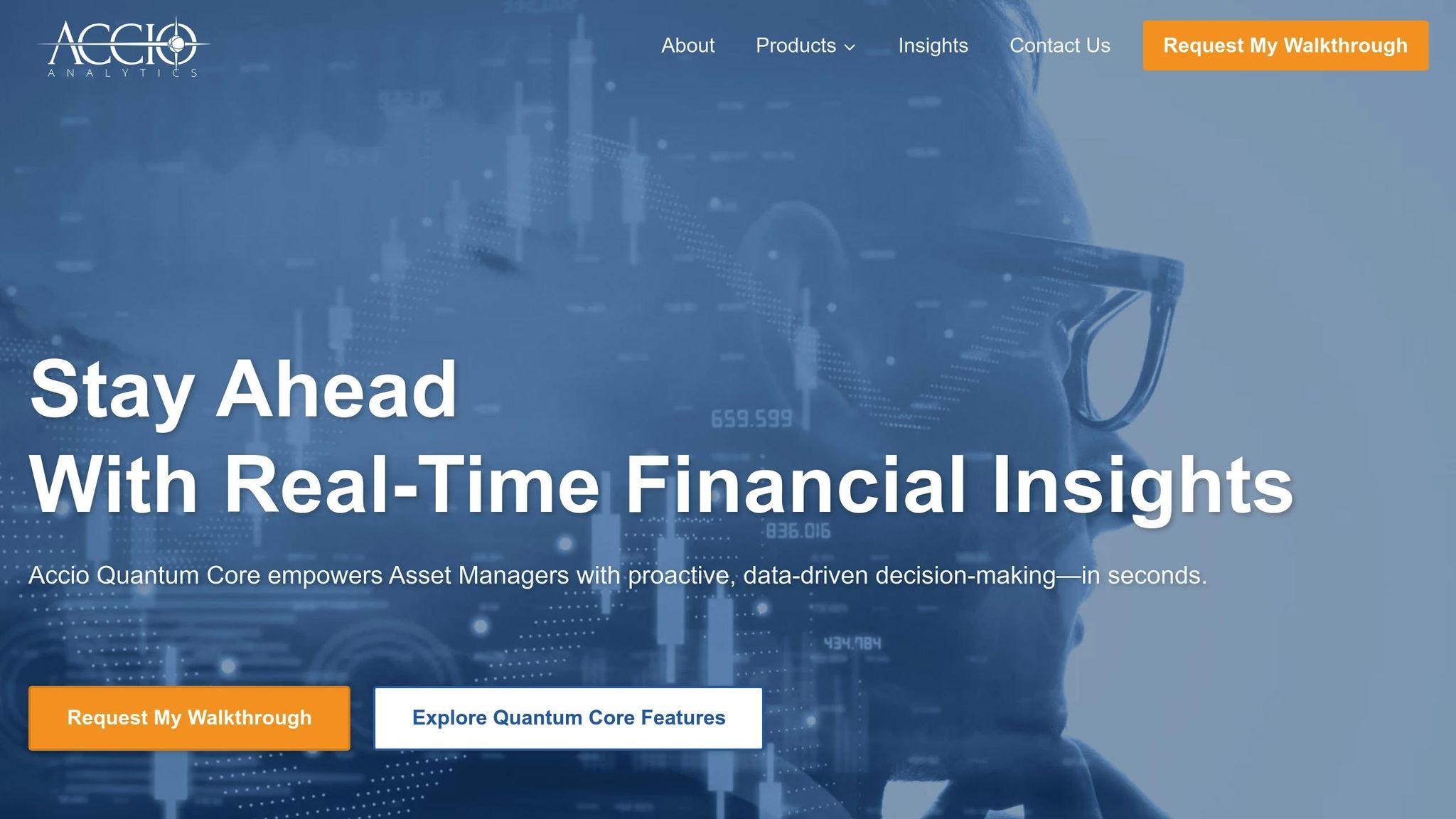AI vs. Legacy Systems: Intraday Volatility Insights
Accio Analytics Inc.
12 min read
Legacy systems are struggling to keep up with the fast-paced demands of modern markets. AI-powered solutions now offer real-time intraday volatility monitoring, enabling asset managers to make faster, more precise decisions. Here’s why AI is transforming this space:
- Speed: AI processes data in milliseconds, unlike legacy systems that rely on overnight batch processing.
- Accuracy: Machine learning adapts to market changes, reducing errors and improving forecasts.
- Flexibility: AI integrates seamlessly with existing systems, avoiding costly overhauls.
- Compliance: Automated audit trails simplify regulatory requirements.
Legacy systems are outdated, slow, and prone to errors. Modern platforms, like Accio Quantum Core, provide real-time insights, dynamic risk management, and scalable solutions to meet the demands of today’s volatile markets. Transitioning to AI isn’t just an upgrade – it’s a necessity for staying competitive.
Quant Radio: Volatility Based Stock Trading with AI and Statistics
Legacy Systems: How They Work and Their Problems
Many companies still rely on systems designed for a time when markets moved slower, and data demands were simpler. These legacy systems are built around outdated assumptions – sluggish data flows, limited processing power, and static user needs. In today’s fast-paced markets, this mismatch creates a competitive disadvantage. One of the biggest culprits is their dependence on outdated batch processing methods.
Batch Processing: Why It Falls Short Today
Legacy systems lean heavily on batch processing, where data is collected throughout the trading day and processed later, often during off-peak hours. While this made sense when computing power was limited, it’s no match for the speed and complexity of modern markets.
Here’s how it typically works: during trading hours, intraday volatility data is gathered from various sources. But instead of being processed in real-time, it’s held until the day ends. By the time the reports are generated and reviewed – usually the next day – market conditions may have changed entirely.
This delay becomes a major issue during periods of rapid market movement. When unexpected swings occur, legacy systems can’t provide the immediate insights needed to protect portfolios or capitalize on opportunities. Portfolio managers are forced to wait for the next processing cycle to make adjustments, which means they miss critical windows for dynamic analysis.
Batch processing also creates inefficiencies. During peak trading hours, when real-time insights are most valuable, system resources often sit idle. Later, these same systems face heavy loads, straining their capacity.
Key Problems with Legacy Systems
The challenges of legacy systems go beyond just batch processing. They struggle with several other critical issues:
- Data Latency: Modern systems can process and analyze market data in milliseconds. Legacy systems, by contrast, often take hours to compile the same information, leaving decision-makers to act on outdated data.
- Manual Processes and Errors: Steps like data extraction, validation, and report generation are often manual, increasing the risk of errors. Over time, these errors can snowball, negatively affecting portfolio performance.
- Inflexibility: Legacy systems are not built to handle today’s dynamic market conditions. As trading volumes or investment strategies evolve, these systems often require extensive reprogramming or overhauls to adapt.
- Technological Roadblocks: Many of these systems rely on outdated programming languages and databases, making it difficult to integrate new market feeds or alternative data sources. This often results in operational silos, where advanced analytics tools can’t connect with core systems.
- Regulatory Challenges: Meeting modern compliance standards is another uphill battle. U.S. regulations now require real-time monitoring and detailed audit trails. Legacy systems often can’t generate the precise, timestamped data needed for quick regulatory responses, making it harder to scale operations in today’s complex market environment.
These limitations highlight why legacy systems struggle to keep up, setting the stage for AI-driven solutions that offer fast, adaptive insights tailored to the demands of modern markets.
AI-Driven Intraday Volatility Monitoring: What It Can Do
AI-powered systems are reshaping how asset management handles intraday volatility. Unlike the slower, traditional methods of the past, these platforms analyze market data as events unfold, offering a more dynamic and responsive approach. This shift is part of a broader move toward integrating AI across asset management processes.
Real-Time Data Processing for Faster Decisions
AI systems work in real time, processing market data during U.S. trading hours (9:30 AM–4:00 PM EST). This allows portfolio managers to detect volatility patterns as they emerge and act quickly. Traditional systems, in contrast, often lag behind, delaying critical decisions. With AI, price movements, volume changes, and volatility indicators are analyzed instantly, giving managers the tools to protect portfolios and seize market opportunities.
What makes these systems even more powerful is their ability to combine multiple data sources – market data, news feeds, social media trends, and economic indicators – into a single, cohesive picture of market activity. Automated alerts notify managers when volatility thresholds are crossed, ensuring timely responses to potential risks.
Improved Accuracy with Machine Learning
Machine learning takes accuracy to another level by continuously adapting to market changes. Unlike older systems that rely on fixed rules, AI models learn from historical data and evolve over time. This adaptability minimizes human errors and ensures predictions stay relevant as market conditions shift. Automated data validation further enhances accuracy by flagging anomalies the moment they occur.
AI models also excel at spotting early signs of market stress and uncovering hidden correlations that human analysts might miss. This capability allows managers to anticipate changes rather than simply react to them. The result? More precise forecasts and better-informed decisions that align with strategic goals.
Key Benefits for Asset Managers
AI-driven monitoring doesn’t just improve data analysis – it transforms how asset managers operate. Dynamic risk profiling adjusts in real time, helping firms identify volatility spikes early and adapt their strategies accordingly. Predictive analytics provide a proactive edge, offering insights into market behavior before trends fully develop.
Compliance becomes less of a headache with AI’s automated audit trails, which document decisions and data points with exact timestamps. This makes meeting regulatory requirements simpler and more efficient. Operationally, AI reduces the time teams spend on routine tasks like data collection, freeing them to focus on strategic analysis. All of this builds client confidence and supports stronger risk management practices.
sbb-itb-a3bba55
AI vs Legacy Systems: Side-by-Side Comparison
The contrast between AI-driven platforms and legacy systems becomes striking when viewed side by side. Legacy systems were designed for a bygone era of financial markets, while AI solutions are built to meet today’s demand for speed, precision, and flexibility in monitoring intraday volatility. This comparison underscores why asset managers increasingly turn to AI for sharper, more dynamic market insights.
Legacy systems operate on batch processing, meaning insights are often delayed until the following day. In contrast, AI systems deliver real-time data processing within seconds. Additionally, legacy platforms depend heavily on manual intervention, which opens the door to human error and outdated assumptions. On the other hand, AI platforms continuously learn from market behavior, validating data automatically and improving accuracy as conditions shift.
Flexibility is where legacy systems face their biggest challenges. When markets experience abrupt changes – like the volatility spike in March 2020 or shifts in interest rates – legacy systems require manual reprogramming and rule updates. AI platforms, however, adapt on their own, learning from new patterns without the need for downtime or significant reconfiguration.
Cost is another key differentiator. Legacy systems demand large upfront investments and ongoing maintenance. In contrast, AI solutions often feature modular architectures, reducing initial costs and making it faster to implement upgrades – all while preserving existing technology investments.
Comparison Table: AI vs Legacy Systems
Here’s a breakdown of the key differences:
| Feature | Legacy Systems | AI-Driven Systems |
|---|---|---|
| Processing Latency | Batch processing (hours/overnight) | Real-time processing (seconds) |
| Response Latency | Next-day insights | Immediate alerts during trading |
| Accuracy | Static rules, manual validation | Machine learning, automated validation |
| Adaptability | Requires manual updates | Automatic learning and adjustment |
| Integration Complexity | Disruptive overhauls needed | Seamless, modular integration |
| Compliance Tracking | Manual audit trails | Automated documentation with timestamps |
| Cost Structure | High upfront, ongoing maintenance | Modular pricing, lower total cost of ownership |
| Scalability | Hardware-dependent limitations | Cloud-based, virtually unlimited scaling |
| Risk Detection | Reactive post-event | Proactive, predictive capabilities |
| Data Sources | Limited, siloed feeds | Multiple integrated sources |
The operational impact of these systems goes beyond technology. Legacy platforms often tie up analysts with repetitive tasks like data collection and validation. AI platforms, by automating these processes, free up teams to focus on strategic decision-making – shifting how firms allocate their expertise.
Regulatory compliance is another area where AI systems excel. Automated audit trails with precise timestamps streamline regulatory reporting and minimize compliance risks. In contrast, legacy systems rely on manual documentation and reconciliation, which not only increases workload but also heightens the risk of errors.
For firms aiming to modernize, legacy systems represent outdated practices that stifle agility in a competitive environment. Platforms like Accio Quantum Core redefine how asset managers monitor intraday volatility, enabling faster decisions, smarter risk management, and better outcomes for clients. Up next, we’ll explore how our platform addresses these challenges with seamless integration and real-time insights.
How Accio Quantum Core Solves Legacy System Problems

Asset managers face the challenge of modernizing how they monitor intraday volatility without disrupting their current operations. Accio Quantum Core tackles this issue directly, offering enhanced real-time data processing while maintaining compatibility with existing systems.
Effortless Integration and Modular Design
Integrating new technology often comes with the risk of operational disruptions. Accio Quantum Core eliminates this concern with its API-driven architecture, allowing firms to incorporate advanced capabilities through straightforward API calls – no need for a full system overhaul [1].
Unlike traditional solutions that require costly and time-consuming replacements, Quantum Core’s modular design lets firms adopt only the components they need, at their own pace. The platform is powered by specialized agents – microservices designed for tasks like holdings calculations, transaction processing, and risk exposure analysis. For instance, a firm can begin by deploying the Holdings Agent for real-time portfolio tracking and later expand by adding the Risk Exposure Agent or Returns Agent as their requirements grow [1][2].
This scalable setup supports incremental upgrades. As data demands increase or market conditions shift, firms can seamlessly add new agents without disrupting their existing infrastructure [1]. Additionally, Quantum Core integrates smoothly with familiar workflows, ensuring teams can continue using their preferred tools and interfaces [1][2].
Real-Time Insights for Smarter Decisions
Quantum Core doesn’t just integrate seamlessly – it transforms how data is used. By shifting from outdated overnight batch reports to live, actionable insights, it enables asset managers to respond to market volatility in real time. This is a game-changer for decision-making.
Legacy systems often leave managers reacting to risks after they’ve already materialized. Quantum Core, on the other hand, provides live performance tracking and allows for instant adjustments to thresholds as market conditions evolve throughout the trading day.
Another standout feature is dynamic threshold management. Instead of relying on rigid, pre-set rules that require manual updates, Quantum Core enables real-time adjustments to risk parameters, volatility thresholds, and performance benchmarks. This adaptability ensures portfolio managers can fine-tune their monitoring criteria as markets shift, avoiding the delays and downtime typical of older systems.
Meeting Compliance Needs and Preparing for the Future
Beyond improved decision-making, Quantum Core addresses the growing complexity of regulatory compliance. U.S. asset managers must navigate stringent requirements from agencies like the SEC and CFTC. Quantum Core simplifies this process with built-in validation and trace functionality, offering the transparency and audit trails regulators demand [1].
By automating compliance tracking, the platform eliminates the manual reconciliation processes that plague legacy systems. Every action – from calculations to threshold adjustments and alerts – is logged with precise timestamps and detailed audit trails. This not only reduces the time and resources spent on regulatory reporting but also minimizes the risk of compliance errors.
Looking ahead, Quantum Core is designed to evolve with the market. Its modular architecture allows firms to adapt to new asset classes, trading venues, and regulatory requirements without overhauling their systems. For example, when additional reporting metrics are needed or a firm expands into new markets, the appropriate agents can be seamlessly added to the existing setup [1].
The platform’s API-first design ensures compatibility with future technologies. Whether it’s connecting to new data sources, integrating with emerging trading platforms, or adopting advanced analytics tools, Quantum Core’s flexible framework supports these advancements without disrupting current operations [1].
For asset managers ready to break free from the constraints of legacy systems, Quantum Core provides a clear path forward. It delivers immediate improvements in intraday volatility monitoring while setting the stage for ongoing growth and innovation, ensuring firms remain competitive in an ever-changing market landscape.
Conclusion: Moving to AI for Better Business Results
AI-driven intraday volatility monitoring represents a major leap forward, shifting risk management from a reactive approach to one that’s proactive. Unlike legacy systems that often delay responses, AI provides real-time detection, enabling faster decisions and the ability to identify regime shifts minutes ahead of traditional workflows [4].
But this shift isn’t just about speed. Neural networks outperform linear regressions and tree-based models in forecasting multi-asset intraday realized volatility, as demonstrated through U.S. high-frequency equity data spanning 2011–2021. These models not only delivered better results but also showed strong adaptability to unseen stocks, reducing the risk of overfitting in multi-asset workflows [8]. This directly translates into measurable performance gains that can significantly impact a firm’s bottom line.
Beyond technical improvements, AI also delivers strategic advantages for executives. Three key outcomes stand out for C-level leaders. First, it enhances capital efficiency and liquidity deployment by enabling earlier detection of peak outflows and irregular events, which improves treasury and trading decisions [3]. Second, faster signal-to-decision times lead to better execution quality and reduced slippage. Third, dynamic risk profiling ensures exposures remain aligned with risk appetite and mandates on an ongoing basis [7]. These benefits not only address the limitations of legacy systems but also provide a competitive edge in the fast-paced U.S. markets, especially during periods of market stress [5].
Regulatory requirements now demand timely and transparent risk monitoring, and AI combined with cloud-based architectures makes real-time visibility into intraday liquidity and volatility possible – something batch systems struggle to achieve [3]. Modern AI platforms also include explainability dashboards and model governance tools, addressing concerns about "black box" models while improving audit readiness [6].
Transitioning to AI doesn’t have to disrupt existing operations. Solutions like Accio Quantum Core demonstrate how firms can strategically integrate modular microservices into their current infrastructure. These tools replace slow batch processes with live performance insights, giving executives the ability to act immediately. Leaders can set strategic thresholds, receive instant feedback, and adjust parameters in real time as markets evolve.
FAQs
How do AI-powered systems help asset managers stay compliant with regulatory requirements?
AI-driven systems are transforming how businesses handle regulatory compliance by offering real-time monitoring and automated reporting. These tools significantly cut down on human errors while ensuring companies stay on top of constantly evolving regulations. Unlike outdated systems, AI can swiftly interpret complex rules, pinpoint compliance gaps, and suggest actionable steps to address potential risks.
By incorporating AI, compliance processes become not just faster but also more precise. This accuracy helps reduce costs and allows businesses to allocate resources toward more strategic goals. These systems provide ongoing, adaptable oversight, helping organizations stay ahead of regulatory updates, avoid costly fines, and maintain trust in their compliance efforts.
What are the key benefits of real-time data processing in AI platforms for asset managers?
Real-time data processing in AI platforms gives asset managers the tools to make quicker, smarter decisions by delivering instant insights as market conditions shift. Unlike older systems that depend on slower batch processing, AI-powered platforms provide the ability to track key metrics live, adapt strategies on the spot, and respond swiftly to market changes.
This capability boosts flexibility and sharpens strategic precision, allowing firms to maintain an edge in rapidly changing markets. With the elimination of delays and the ability to make immediate adjustments, asset managers can confidently handle volatility and capitalize on emerging opportunities.
Why is upgrading from legacy systems to AI-powered solutions critical for staying ahead in today’s markets?
Upgrading from older systems to AI-powered solutions is becoming essential for asset management firms. Why? AI delivers real-time data analysis, allowing companies to gain faster, more accurate insights – especially important in unpredictable markets. This speed and precision enable quicker, well-informed decisions, helping firms avoid missed opportunities.
Beyond just insights, AI-driven systems can significantly cut operational costs, handle growth more effectively, and provide live, dynamic updates – something traditional systems simply can’t do. By embracing AI, firms position themselves to keep up with market shifts, stay ahead of competitors, and prepare for the industry’s ever-changing demands.




